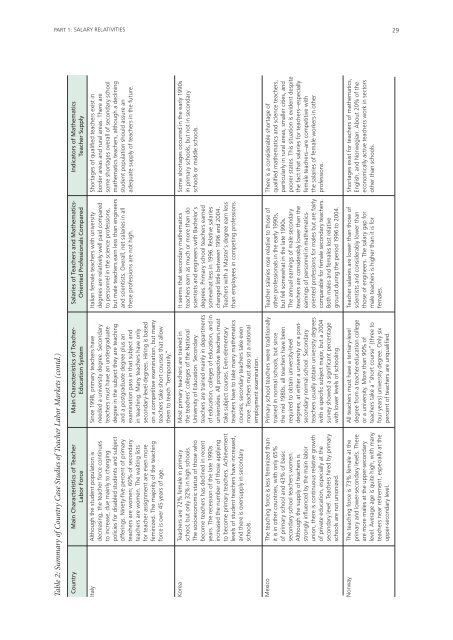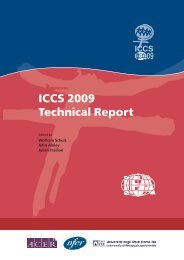Teacher Education and Development Study in Mathematics - IEA
Teacher Education and Development Study in Mathematics - IEA
Teacher Education and Development Study in Mathematics - IEA
Create successful ePaper yourself
Turn your PDF publications into a flip-book with our unique Google optimized e-Paper software.
PART 1: SALARY RELATIVITIES<br />
29<br />
Table 2: Summary of Country Case Studies of <strong>Teacher</strong> Labor Markets (contd.)<br />
Country Ma<strong>in</strong> Characteristics of <strong>Teacher</strong> Ma<strong>in</strong> Characteristics of <strong>Teacher</strong>- Salaries of <strong>Teacher</strong>s <strong>and</strong> <strong>Mathematics</strong>- Indicators of <strong>Mathematics</strong><br />
Labor Force <strong>Education</strong> System Oriented Professionals Compared <strong>Teacher</strong> Supply<br />
Italy<br />
Although the student population is<br />
decreas<strong>in</strong>g, the teacher force cont<strong>in</strong>ues<br />
to <strong>in</strong>crease, due ma<strong>in</strong>ly to chang<strong>in</strong>g<br />
policies for disabled students <strong>and</strong> subject<br />
offer<strong>in</strong>gs. N<strong>in</strong>ety-five percent of primary<br />
teachers are women; 60% of secondary<br />
teachers are women. The wait<strong>in</strong>g lists<br />
for teacher assignment are even more<br />
fem<strong>in</strong>ized. The majority of the teach<strong>in</strong>g<br />
force is over 45 years of age.<br />
S<strong>in</strong>ce 1998, primary teachers have<br />
needed a university degree. Secondary<br />
teachers must have an undergraduate<br />
degree <strong>in</strong> the subject they are teach<strong>in</strong>g<br />
<strong>and</strong> a postgraduate degree plus an<br />
exam<strong>in</strong>ation pass <strong>in</strong> that subject <strong>and</strong><br />
<strong>in</strong> teach<strong>in</strong>g. Many teachers have only<br />
secondary-level degrees. Hir<strong>in</strong>g is based<br />
on a competitive exam<strong>in</strong>ation, but many<br />
teachers take short courses that allow<br />
them to teach “temporarily.”<br />
Italian female teachers with university<br />
degrees are relatively well paid compared<br />
to personnel <strong>in</strong> the science professions,<br />
but male teachers earn less than eng<strong>in</strong>eers<br />
<strong>and</strong> scientists. Overall, net salaries <strong>in</strong> all<br />
these professions are not high.<br />
Shortages of qualified teachers exist <strong>in</strong><br />
border areas <strong>and</strong> rural areas. There are<br />
some shortages overall of secondary school<br />
mathematics teachers, although a decl<strong>in</strong><strong>in</strong>g<br />
student population should assure an<br />
adequate supply of teachers <strong>in</strong> the future.<br />
Korea<br />
<strong>Teacher</strong>s are 72% female <strong>in</strong> primary<br />
school, but only 32% <strong>in</strong> high schools.<br />
The socioeconomic status of those who<br />
become teachers has decl<strong>in</strong>ed <strong>in</strong> recent<br />
years. The recession of the late 1990s<br />
<strong>in</strong>creased the number of those apply<strong>in</strong>g<br />
to become primary teachers. Achievement<br />
levels of student teachers have <strong>in</strong>creased,<br />
<strong>and</strong> there is oversupply <strong>in</strong> secondary<br />
schools.<br />
Most primary teachers are tra<strong>in</strong>ed <strong>in</strong><br />
the teachers’ colleges of the National<br />
University of <strong>Education</strong>. Secondary<br />
teachers are tra<strong>in</strong>ed ma<strong>in</strong>ly <strong>in</strong> departments<br />
of education, colleges of education, <strong>and</strong> <strong>in</strong><br />
universities. All prospective teachers must<br />
take subject courses. Even elementary<br />
teachers have to take many mathematics<br />
courses; secondary teachers take even<br />
more. <strong>Teacher</strong>s must also sit a national<br />
employment exam<strong>in</strong>ation.<br />
It seems that secondary mathematics<br />
teachers earn as much or more than do<br />
scientists <strong>and</strong> eng<strong>in</strong>eers with Bachelor’s<br />
degrees. Primary school teachers earned<br />
somewhat less <strong>in</strong> 1996. Relative salaries<br />
changed little between 1996 <strong>and</strong> 2004.<br />
<strong>Teacher</strong>s with a Master’s degree earn less<br />
than employees <strong>in</strong> compet<strong>in</strong>g professions.<br />
Some shortages occurred <strong>in</strong> the early 1990s<br />
<strong>in</strong> primary schools, but not <strong>in</strong> secondary<br />
schools or middle schools.<br />
Mexico<br />
The teach<strong>in</strong>g force is less fem<strong>in</strong>ized than<br />
it is <strong>in</strong> other countries, with only 65%<br />
of primary school <strong>and</strong> 43% of basic<br />
secondary school teachers women.<br />
Although the supply of teachers is<br />
strongly <strong>in</strong>fluenced by the ma<strong>in</strong> labor<br />
union, there is cont<strong>in</strong>uous relative growth<br />
of private education, especially at the<br />
secondary level. <strong>Teacher</strong>s hired by primary<br />
schools are not unionized.<br />
Primary school teachers were traditionally<br />
tra<strong>in</strong>ed <strong>in</strong> normal schools, but s<strong>in</strong>ce<br />
the mid 1980s, all teachers have been<br />
required to obta<strong>in</strong> university-level<br />
degrees, at either a university or a postsecondary<br />
normal school. Secondary<br />
teachers usually obta<strong>in</strong> university degrees<br />
with a specific subject major, but a 2004<br />
survey showed a significant percentage<br />
with lower levels of school<strong>in</strong>g.<br />
<strong>Teacher</strong> salaries rose relative to those of<br />
other professionals <strong>in</strong> the early 1990s,<br />
but fell somewhat <strong>in</strong> the late 1990s.<br />
The annual earn<strong>in</strong>gs of male secondary<br />
teachers are considerably lower than the<br />
earn<strong>in</strong>gs of personnel <strong>in</strong> mathematicsoriented<br />
professions for males but are fairly<br />
comparable for female secondary teachers.<br />
Both males <strong>and</strong> females lost relative<br />
ground dur<strong>in</strong>g the period 1996 to 2004.<br />
There is a considerable shortage of<br />
qualified mathematics <strong>and</strong> science teachers,<br />
particularly <strong>in</strong> rural areas, smaller cities, <strong>and</strong><br />
poorer states. This situation is evident despite<br />
the fact that salaries for teachers—especially<br />
female teachers—are competitive with<br />
the salaries of female workers <strong>in</strong> other<br />
professions.<br />
Norway<br />
The teach<strong>in</strong>g force is 73% female at the<br />
primary <strong>and</strong> lower-secondary levels. There<br />
are more males at the upper-secondary<br />
level. Average age is quite high, with many<br />
teachers near retirement, especially at the<br />
upper-secondary level.<br />
All teachers must have a tertiary-level<br />
degree from a teacher-education college<br />
or a university. More than 90% of<br />
teachers take a “short course” (three to<br />
four years) university degree. Only six<br />
percent of teachers are unqualified.<br />
<strong>Teacher</strong> salaries are lower than those of<br />
scientists <strong>and</strong> considerably lower than<br />
those of eng<strong>in</strong>eers. The salary gap for<br />
male teachers is higher than it is for<br />
females.<br />
Shortages exist for teachers of mathematics,<br />
English, <strong>and</strong> Norwegian. About 20% of the<br />
economically active teachers work <strong>in</strong> sectors<br />
other than schools.

















